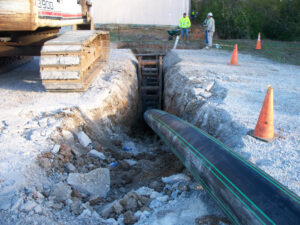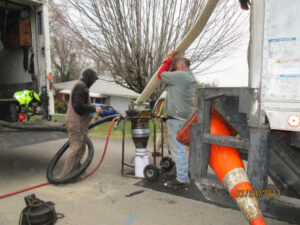By Greg Jones, PE
After completing an evaluation of the gravity sewer system, an engineer will determine if problems exist. When a problem is identified, an engineer will determine the best sewer rehabilitation method. There are several rehabilitation methods available in the engineer’s toolbox. However, the following rehabilitation methods are most commonly used to repair gravity sewer lines.
POINT REPAIRS: When there are only one or two problems in a section of serviceable pipe, the best option could be an Open Cut Point Repair, depending on the location of the repair. An Open Cut Point Repair consists of excavating the damaged sewer line, removing the damaged pipe segment, and installing a new pipe segment. The excavated area would then be backfilled with gravel and the street or yard will be restored to its original condition. This method may involve replacing a line segment over 20 feet long but is typically for shorter sections of pipe.
Trenchless point repairs are often used in areas where excavation of the damaged pipe is not an option due to excessive depth or close proximity to buildings or other structures. Trenchless options are Cured in Place Pipe (CIPP) Internal Point Repair, Chemical Grouting, Internal Seals, and Robotic Repairs. Factors to consider include the location of gravity sewer line, type of damage, and depth. These are only a few of the items that must be considered to determine the best point repair option.
PIPE BURSTING: If a sewer line has numerous severely damaged areas, it is usually more cost effective to repair the entire pipe section rather than make multiple point repairs. One trenchless option to consider is Pipe Bursting technology. Pipe Bursting can be used to renew the existing gravity sewer line or to increase the hydraulic capacity of the existing line. This typically involves the use of high density polyethylene (HDPE) pipe. Sections of HDPE pipe are welded together to equal the total length of the original sewer pipe section.
A bursting head is attached to the front of the new pipe and inserted into the existing line/pipe through an excavated insertion pit. The bursting head is forced through the existing pipe, destroying the existing pipe and pushing the pipe fragments into the void space around the bursting head. The new sewer line/pipe, typically HDPE pipe, is pulled or pushed through the void created by the bursting head. The HDPE pipe then replaces the damaged sewer pipe without excessive disturbance at ground level.
CURED IN PLACE PIPE (CIPP): CIPP is a trenchless pipeline renewal process to repair leaks due to structural and non-structural issues. The CIPP process involves the use of a special flexible-fiber sleeve soaked with a heat activated resin. The function of the flexible-fiber sleeve is to support the resin during the installation process.
The fiber sleeve with the resin is stored in a refrigerated truck until the installation process begins to preserve its heat-activated bonding agents. The sleeve is inserted into the existing sewer line using water pressure, air pressure, or a winch system. After it is inserted, the CIPP system is cured using hot water, steam, or ultraviolet lighting. The curing process activates the resin to complete the renewal process. Although the volume of the pipe is reduced by a small degree, the smoothness of the CIPP compensates by reducing friction. CIPP lining is capable of navigating through bends, existing pipe deformations, and non-circular shapes, often without reducing the hydraulic capacity of the pipe.
SLIP-LINING (SL): Pipe materials utilized in the SL process can be HDPE, Poly Vinyl Chloride (PVC), or glassfiber reinforced polyester (GRP). This process is where a new pipe of slightly smaller diameter is inserted by pulling or pushing it through the entire length of the original pipe. Grout is placed between the walls of the original pipe and the new pipe. The installation method can be either continuous or segmental. This method reduces the inner diameter of the pipe segment. As a result, it is important to evaluate the hydraulic capacity of the existing line to determine if this method is the best option.
DIG-AND-LAY (Open Cut): Open cut construction activities include excavating a trench along the length of the new sewer pipe line and installing a new pipe using proper bedding and backfill material. Construction of a new line by the open cut method can damage existing utilities, roadways, sidewalks, yards, and landscaping. So, at the completion of the project all of the damaged areas must be repaired. The open cut method is not always the most economical method. This method is typically used when an area’s sanitary sewer system needs to be improved due to pipe slope issues, hydraulic capacity issues, sags within the sewer line, or when long lengths of pipes are in such poor condition that they need to be completely replaced.
There are numerous design factors to consider in choosing the proper sewer rehabilitation method. Some of these include construction costs, hydraulic capacity, location of the existing sewer line, existing utilities, subsurface material, and buildings that could interfere with construction activities. All construction projects should include engineering construction administration and resident project representation to confirm construction practices and materials follow the specifications and that proper testing is performed. LDA Engineering has proven experience in all methods of pipeline rehabilitation and has assisted numerous clients to successfully rehabilitate their sanitary sewer systems.


